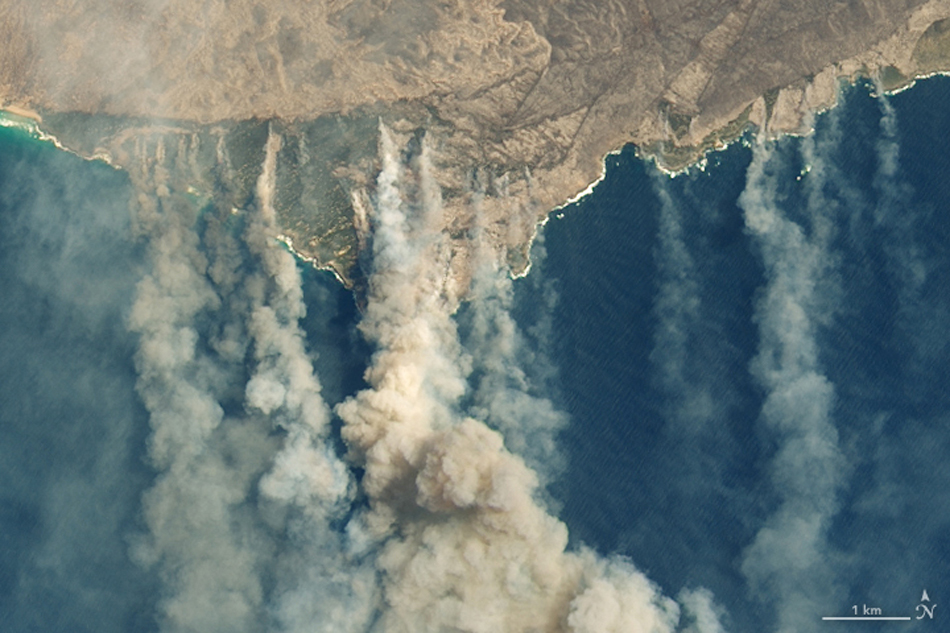Bushfires, not pandemic lockdowns, had biggest impact on global climate in 2020
Smoke from Australian fires affected temperatures, storm tracks
Jul 27, 2021 - by David Hosansky
Jul 27, 2021 - by David Hosansky

An image from NASA's Landsat 8 satellite shows smoke billowing from major fires on Australia's Kangaroo Island in early 2020.
When a team of scientists began analyzing events that influenced the world’s climate in 2020, they made sure to consider the pandemic-related lockdowns that reduced emissions and led to clearer skies over many cities.
But they found that an entirely different event had a more immediate impact on global climate: the devastating bushfires that burned through Australia from late 2019 to 2020, pumping plumes of smoke that reached the stratosphere and circled much of the southern hemisphere.
“The main climate forcing of 2020 wasn’t COVID-19 at all,” said John Fasullo, a scientist at the National Center for Atmospheric Research (NCAR) and the lead author of the new study. “It was the explosion of wildfires in Australia.”
The study is being published online today in Geophysical Research Letters, an American Geophysical Union journal.
Fasullo and his NCAR co-authors used advanced computer modeling techniques to quantify the climatic influence of the reductions in traffic and industrial activity related to COVID-19, as well as the smoke emitted by the fires. They found that the pandemic-related lockdowns of 2020 had a relatively modest and gradual influence that will result in an average warming worldwide of about .05 degrees Celsius by the end of 2022. In contrast, the fires had a briefer but more significant impact, cooling the planet within months by about .06 degrees Celsius.
The study illuminates the surprisingly wide-ranging effects of major wildfires on the world’s climate system. Although it may seem counterintuitive that fires, which are associated with hot weather, can have a temporary cooling influence, their smoke tends to block sunlight and modify clouds.
Scientists have conducted a number of studies into the potential effects of warming temperatures on wildfires, which have become increasingly destructive in recent years, as well as the localized impacts of fires on weather. But they have devoted less research into what the blazes may portend for large-scale temperature and precipitation patterns.
The NCAR research indicates that major fires inject so many sulfates and other particles into the atmosphere that they can disrupt the climate system, push tropical thunderstorms northward from the equator, and potentially influence the periodic warming and cooling of tropical Pacific Ocean waters known as El Niño and La Niña.
“What this research shows is that the impact of regional wildfire on global climate can be substantial,” Fasullo said. “There are large-scale fingerprints from the fires in both the atmosphere and ocean. The climate response was on par with a major volcanic eruption.”
He and his co-authors cautioned that a range of caveats applies to the study, largely because of uncertainties about the full extent of emission reductions during the lockdown and the exact climatic effects of wildfire smoke.
The study was funded by the National Science Foundation, which is NCAR’s sponsor, as well as by NASA and the U.S. Department of Energy.
To detect the climatic influence of the pandemic and wildfires, the research team turned to estimates of emissions from both these events. They then used the NCAR-based Community Earth System Model to run a series of simulations to recreate global climate — both with the actual emissions and without them — as well as under various atmospheric conditions and over a time period from 2015 to 2024. This allowed them to capture the difference that the emissions made to the world’s climate and to glean more insights than would be possible from observations alone.
The intensive simulations, more than 100 in all, were performed on the Cheyenne supercomputer at the NCAR-Wyoming Supercomputing Center.
As they expected, Fasullo and his co-authors found that the lockdowns associated with COVID-19 had a slight warming influence on global climate. This effect, which other scientific studies have shown on a regional level, has to do with the clearer skies that resulted from fewer emissions, which enabled more of the Sun’s heat to reach Earth’s surface.
In contrast, the Australian bushfires cooled the Southern Hemisphere to such an extent that they lowered Earth’s average surface temperatures. This is because sulfates and other smoke particles interact with clouds to make their droplets smaller and reflect more incoming solar radiation back to space, reducing the absorption of sunlight at the surface.
At their peak, the pandemic-related lockdowns led to an increase of solar energy at the top of the atmosphere of about 0.23 watts per square meter, which is a measure used by climate scientists to quantify the amount of solar heat entering and leaving Earth’s atmosphere. In contrast, the Australian fires temporarily cooled the globe by almost a watt per square meter. (For perspective, the average intensity of solar energy at the top of the atmosphere directly facing the Sun is about 1,360 watts per square meter.)
By circling the Southern Hemisphere and lingering in the atmosphere for months, the smoke particles disproportionately cooled the southern half of the planet. As a result, the disparity between hemispheric temperatures displaced tropical thunderstorms farther to the north than usual. Fasullo said that further research is needed to determine if the smoke had additional impacts, such as affecting El Niño and La Niña.
“We’ve theorized that the climate system responds this way to major volcanic eruptions,” Fasullo said. “But those tend to happen every 30 years or so. In contrast, major wildfires can occur every couple of years and therefore have more recurring impacts. We clearly need to learn more about how they affect global climate.”